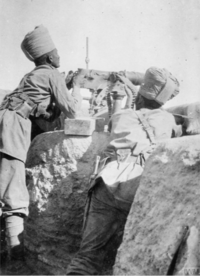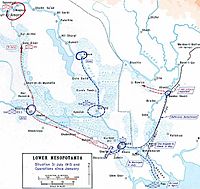Battle of Shaiba facts for kids
Quick facts for kids Battle of Shaiba |
|||||||||
|---|---|---|---|---|---|---|---|---|---|
| Part of the Mesopotamian Campaign of World War I | |||||||||
 Machine gunners of the 120th Rajputana Rifles at the Battle of Shaiba, 12 April 1915 |
|||||||||
|
|||||||||
| Belligerents | |||||||||
| Commanders and leaders | |||||||||
| Major General Charles Melliss | Lieutenant Colonel Süleyman Askerî | ||||||||
| Strength | |||||||||
| 6,156 | 18,000 | ||||||||
| Casualties and losses | |||||||||
| 1,570 | 2,435 | ||||||||
| Approximate figures | |||||||||
The Battle of Shaiba was an important fight during World War I. It happened between April 12 and 14, 1915. British forces fought against Ottoman (Turkish) forces near the city of Basra in what is now southern Iraq. The Ottoman army wanted to take Basra back from the British. But the British won, which was a big step in their control of the area.
Contents
Why the Battle Happened
The British had already captured Basra. This city was very important for communication and industry. After taking Basra, the British made their hold stronger. They also brought in more soldiers. The Ottoman Empire gathered its troops. They planned a big attack to get Basra back. Their goal was to push the British out of Mesopotamia.
The Battle of Shaiba
The Ottoman commander, Süleyman Askeri, led about 4,000 regular soldiers. He also had many irregular Arab and Kurdish fighters, possibly 14,000 of them. This made his total force about 18,000 men. He decided to attack the British positions near Shaiba. This area was southwest of Basra.
Traveling between Basra and Shaiba was hard. Seasonal floods had turned the land into a big lake. So, soldiers had to move by boat. The British camp at Shaiba had about 7,000 men. It was a strong camp with trenches and barbed wire defenses.
First Attacks
At 5 AM on April 12, the Ottoman troops started firing their cannons. That evening, as it got dark, they tried to sneak through gaps in the British barbed wire. But the British soldiers pushed them back. By the morning of April 13, the Ottoman troops had gone back to their positions. These were located at a place called Barjisiyeh Wood.
Later that day, it became clear that some Ottoman and Arab fighters were trying to go around Shaiba. They hoped to reach Basra by avoiding the town. The British, led by General Charles Melliss, sent cavalry to attack these groups. The 7th Hariana Lancers and later the 104th Wellesley's Rifles tried to stop them. However, these attacks were not successful.
British Counter-Attack
General Melliss then launched a stronger attack. He used the 2nd Dorsets and the 24th Punjabis. They were supported by artillery fire. This attack was much more effective. They defeated the Arab irregular fighters. About 400 Arabs were captured, and the rest scattered. These Arab forces did not take part in the rest of the battle.
Süleyman Askeri pulled his regular Ottoman troops back to Barjisiyeh Wood.
Final Push
On April 14, the British left Shaiba to find the remaining Ottoman forces. They found them at Barjisiyeh Wood. The fighting started around 10:30 AM and lasted until 5 PM. General Melliss had to move his soldiers around during the battle. This helped them attack the Ottoman positions better.
The Ottoman firing was very strong. By 4 PM, the British attack had slowed down. The soldiers were thirsty and running low on ammunition. The Ottoman regular troops showed no signs of giving up. Then, the Dorsets launched a brave bayonet charge. This meant they ran at the enemy with bayonets fixed to their rifles. The other Indian troops followed their lead. The Ottomans were overwhelmed and had to retreat from the battlefield. The British were very tired from the day's fighting. They also had little transport and their cavalry was busy elsewhere. So, they did not chase the retreating Ottomans.
The British called this battle a "soldier's battle." This means it was a very tough fight for the infantry (foot soldiers). They felt that the soldiers, especially the British troops, were the ones who won the day.
What Happened After
The Battle of Shaiba was very important. It was the last time the Ottoman Empire seriously threatened Basra. After this battle, the British generally had the upper hand in Mesopotamia. The battle also changed how the local Arab people felt. They started to distance themselves from the Ottomans. Later, revolts against Ottoman rule broke out in cities like Najaf and Karbala.
Major George Godfrey Massy Wheeler of the 7th Hariana Lancers was given a special award. He received the Victoria Cross for his brave actions during the battle. This award was given after he died in battle.
See also


